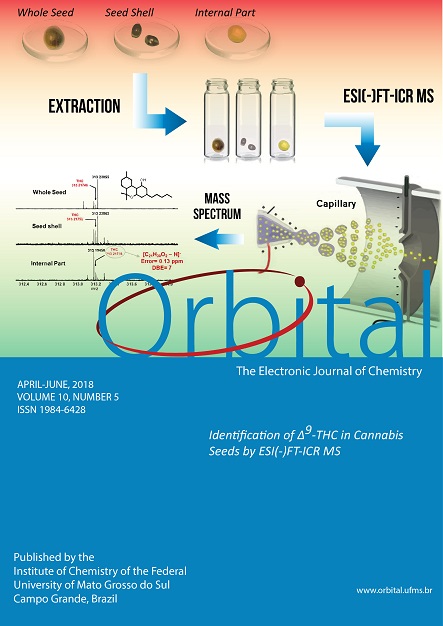Synthesis, Characterization and in vitro Antibacterial Studies of Novel Transition Metal (II) Complexes of 2,5-Diamino-2-(difluoromethyl)pentanoic Acid Hydrochloride Hydrate
- 2,5-diamino-2-(difluoromethyl) pentanoic acid hydrochloride hydrate,
- metal carboxylate
Copyright (c) 2018 Orbital: The Electronic Journal of Chemistry

This work is licensed under a Creative Commons Attribution-NonCommercial-NoDerivatives 4.0 International License.
Abstract
The synthesis and characterization of novel transition Metal (Cu(II), Co(II), Ni(II) and Zn (II)) complexes of 2,5-diamino-2-(difluoromethyl) pentanoic acid hydrochloride hydrate (DPH) have been described. The ligand and metal complexes were characterized by Melting point, Conductivity measurement, Elemental analysis, Fourier Transform infrared (FTIR) spectroscopy, Electronic spectroscopy, Magnetic susceptibility measurement and Electrospray Ionization Mass Spectrometry (ESI-MS). The FTIR spectral data suggests that the ligand behaves as a bidentate ligand coordinates to the metal ions through an oxygen atom of the carboxylate and a nitrogen atom of amino group. The terminal amino group of the ligand is protonated to form NH3+ while the carboxylic moiety is deprotonated forming zwitterionic complexes. Electronic spectral and magnetic studies data suggest that the complexes of Cu(II), Co(II) and Ni(II) have octahedral geometry around metal ions while tetrahedral geometry was proposed Zn (II) ion. In vitro anti-bacterial activities of the ligand and metal complexes were carried out using agar diffusion method against two gram-positive bacteria (Staphylococcus aureus, Bacillus substilis) and two gram-negative bacteria (Escherichia coli, Klebsiella pneumonia). The results obtained revealed that the metal complexes showed enhanced antibacterial activities against the four micro-organisms with lowest minimum inhibitory concentration (MIC) when compared to parent compound.

